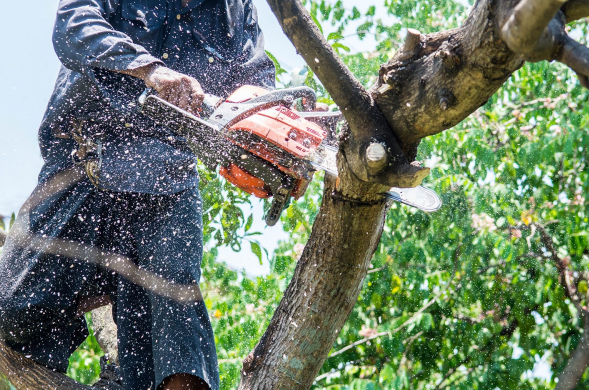Safeguarding New York’s Urban Trees

New York City’s urban trees face unique challenges due to the fast-paced, high-density environment. These trees, which contribute to improved air quality, temperature regulation, and city aesthetics, are exposed to various stressors that can jeopardize their health. From air pollution and compacted soil to limited water access, recognizing the signs of tree stress early is essential for sustaining New York’s green spaces. This guide identifies these signs and provides insights into the main factors affecting tree health in urban areas and strategies to mitigate these stressors. Key Takeaways: Common Stress Factors in Urban Environments: Trees in New York’s urban environment are constantly battling air pollution, soil compaction, and insufficient water due to the abundance of impervious surfaces. The proximity to heavy foot traffic, vehicles, and construction adds further stress, often resulting in poor health or death if not addressed early. Visual and Environmental Signs of Tree Stress: Detecting stress early through signs like discolored leaves, peeling bark, dead branches, and compacted soil prevents further decline. These visual cues, poor soil conditions, and proximity to construction provide essential indicators of a tree’s health status in a busy urban setting. Preventative Measures and Recovery: Urban trees can recover from stress if the right actions are taken promptly. Effective strategies include watering schedules, aerating compacted soil, pruning damaged branches, and protecting tree trunks from physical damage. Community and city-wide initiatives, such as tree planting and maintenance programs, are crucial in reducing tree stress and ensuring the longevity of urban greenery. Common Causes of Tree Stress in Urban Environments Urban environments, like New York City, present unique challenges for trees not found in natural ecosystems. Several factors contribute to tree stress, and understanding these can help take preventative measures to protect urban greenery. Pollution Airborne Pollutants: City trees are exposed to pollutants from traffic, industry, and even nearby construction sites. Pollutants like sulfur dioxide, carbon monoxide, and nitrogen oxides can damage tree leaves, reducing their ability to photosynthesize effectively. Prolonged exposure can lead to long-term damage, such as leaf discoloration and premature leaf drop. Effects on Leaves and Bark: Pollutants can accumulate on leaf surfaces, obstructing the stomata (pores) trees use to breathe. Over time, pollutants may cause the bark to crack or peel, exposing trees to further damage from pests and diseases. Pollution Source Impact on Trees Vehicle Emissions Discoloration and premature leaf drop Industrial Pollutants Cracked bark, reduced photosynthesis Construction Dust Accumulation on leaf surfaces Soil Compaction Urban Soil Conditions: In densely populated cities, high pedestrian traffic, construction activities, and vehicle movement often compact the soil around tree roots. Compacted soil reduces the air and water that can penetrate the ground, limiting the oxygen supply to the roots, which is essential for root respiration and nutrient uptake. Effects on Root Systems: Soil compaction can lead to weak, shallow root systems, making trees more susceptible to tipping over or developing diseases. In extreme cases, compacted soil can suffocate the roots, causing tree death. Source of Compaction Effect on Roots Pedestrian Traffic Limits air and water flow to roots Construction Activities Weakens root structures, limits nutrient uptake Water Stress Limited Water Access: Urban trees often suffer from water stress due to the prevalence of concrete surfaces and drainage systems that prevent rainwater from seeping into the ground. Instead of being absorbed by the roots, water runs off into the streets or storm drains, depriving the trees of the needed moisture. Drought-Like Conditions: Inadequate watering further stresses trees during dry seasons or heat waves. The combination of insufficient rainfall, high concrete evaporation rates, and limited root expansion space can significantly affect tree health. Cause of Water Stress Impact on Tree Health Concrete Surfaces Limits water absorption by the roots Poor Drainage Causes drought-like conditions for trees Urban Heat Island Effect Increases water evaporation and dehydration Physical Damage Construction and Traffic: In urban environments, tree trunks and roots often face physical damage from vehicles, construction equipment, and foot traffic. Digging can severed roots, and trunks may be scraped or damaged by passing machinery. This damage weakens the tree’s structure and opens it up to infections from pests and diseases. Vandalism: Unfortunately, urban trees are also subject to vandalism, such as bark carving, branch breaking, or other intentional harm. This further contributes to their stress and limits their growth and recovery. Source of Physical Damage Effect on Tree Vehicle Impact Weakens trunk and branches Construction Machinery It cuts roots and exposes trees to infection. Vandalism It damages the bark and affects the tree’s healing process. Pests and Diseases Urban Pests: City trees are more vulnerable to pests due to the lack of biodiversity and natural predators. Trees can become infested by pests like aphids, gypsy moths, and emerald ash borer, which feed on the leaves, bark, or sap of the tree and weaken it. Diseases: Urban trees are also prone to diseases like Dutch Elm Disease, which spreads quickly in densely planted areas. Left untreated, they can cause tree dieback, reduced leaf production, and eventual death. Common Urban Pests Common Urban Tree Diseases Emerald Ash Borer Dutch Elm Disease Gypsy Moth Oak Wilt Aphids Powdery Mildew Visual Signs of Tree Stress In urban environments like New York City, early identification of tree stress is crucial to prevent further decline. Visual cues often serve as the first warning signs that a tree is struggling. Recognizing these signs allows for timely interventions, which can help save trees from irreversible damage. Discoloration of Leaves Yellowing Leaves: Yellowing leaves frequently indicate poor nutrition, especially in nitrogen or water. In urban settings, where water and nutrients are harder to come by, leaf discoloration is a common sign of stress. Other potential causes include soil pH imbalances or damage from pollution. Browning Leaves: Browning can indicate more severe issues, such as prolonged water stress, excessive exposure to salt (from winter de-icing), or disease. Depending on the severity of the problem, leaves may exhibit browning edges or complete browning. Leaf Color Change Potential Cause Yellowing Nutrient deficiency, lack of water Browning Water stress,




